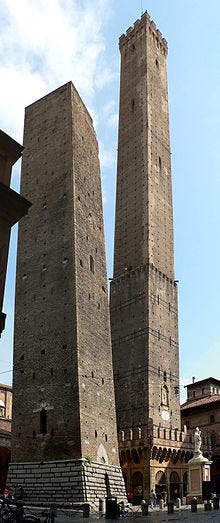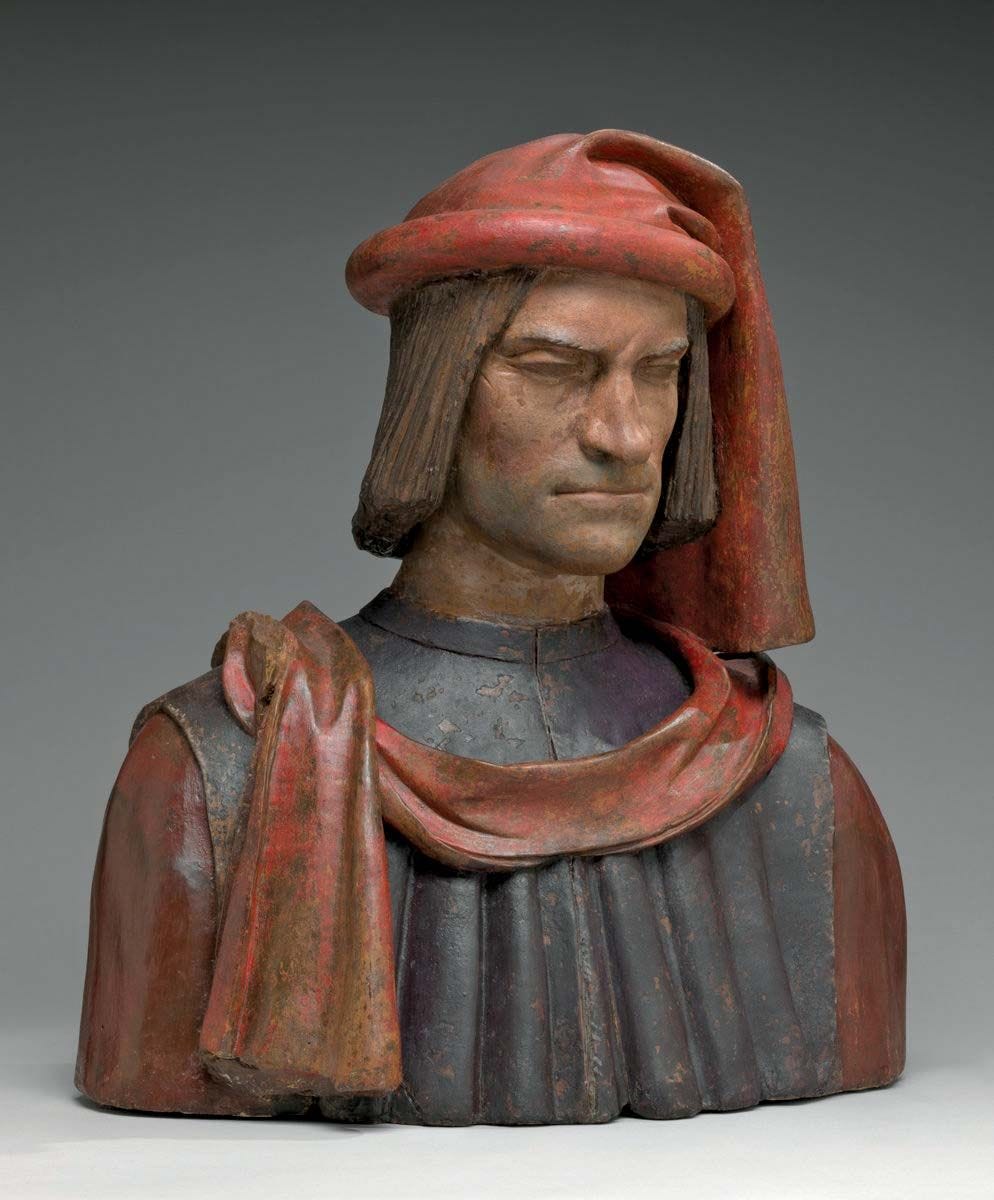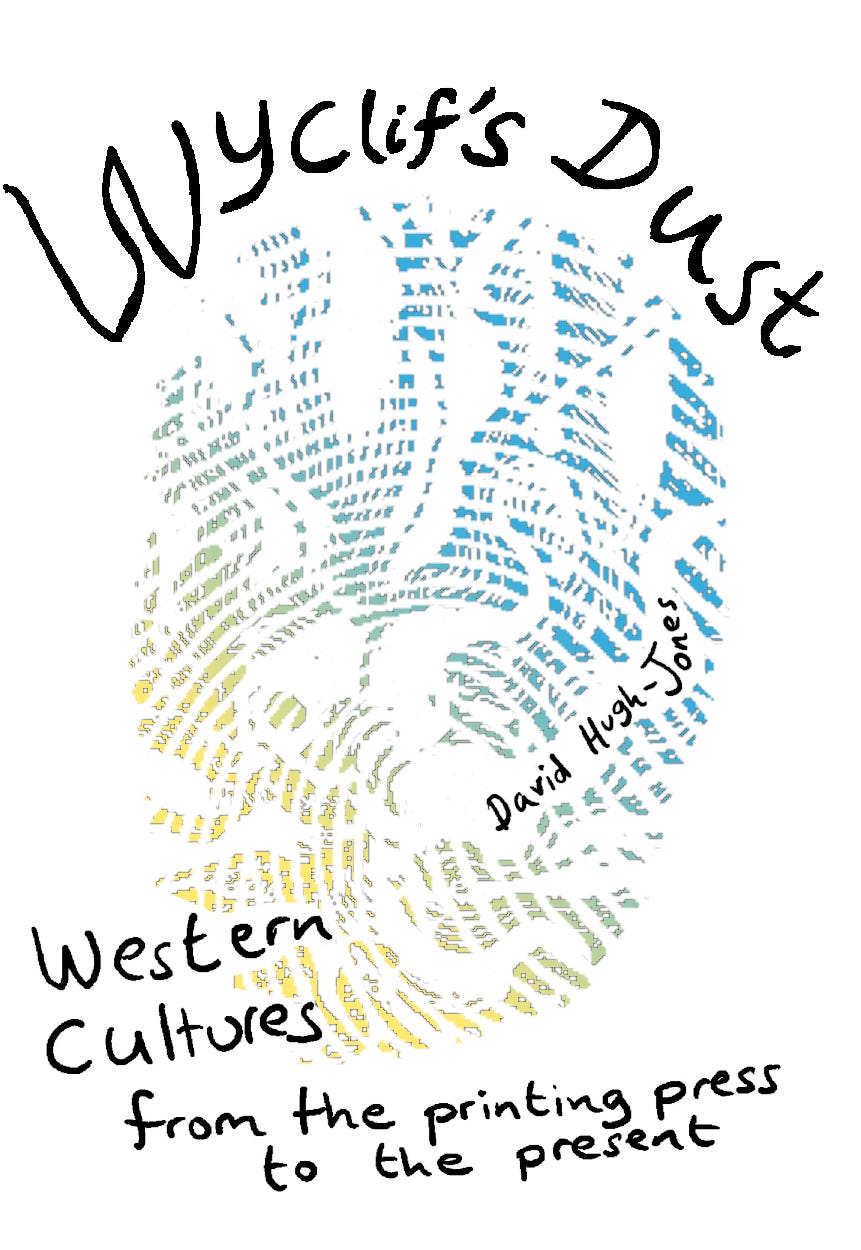

The Italian city-states as a distant mirror
source link: https://wyclif.substack.com/p/the-italian-city-states-as-a-distant
Go to the source link to view the article. You can view the picture content, updated content and better typesetting reading experience. If the link is broken, please click the button below to view the snapshot at that time.
The Italian city-states as a distant mirror
Two possible images of the future
My thinking about the political future is dominated by two clashing master-images. The first image is the continuing backwash of freedom across the globe from West to East. This started when settlers from the Atlantic seaboard colonized North America, made up their own rules to govern their societies, and eventually threw off the metropolis, starting with the American Revolution. The first wave of the backwash rolled up on European shores when France, having spent its treasure supporting the American rebels, faced bankruptcy and was forced to call the Estates General. It carried on when Garibaldi brought his techniques of guerrilla warfare back from Latin America to Italy. In the twentieth century, the armed might of the United States imported freedom to central Europe. Perhaps now, with Ukraine, the wash will keep moving East. Another wave spread across the Pacific, to Japan after 1945, and then to countries along the Asian seaboard. It might yet go inland from there.
This is the standard story of democratization as modernization, with a geopolitical twist — countries don't develop liberal democratic institutions independently, but with the support of their neighbours. On the other side, Russia has been exporting reaction since the days of the Tsar. I don't have much original to say about this grand and inspiring world-historical image. I just hope it comes true.
The second image is less well-known and less optimistic. It is that present-day Europe and the West look like the Renaissance city-states of Italy.
The Italian city-states were rich, powerful, economically dynamic, politically advanced, and culturally dominant. They were laid low by neighbours which started off as less of all these things, but which had the great advantage of scale. In the end, they became a backwater. That is really all I knew, but it was enough to raise alarming parallels with European states today, so I thought it would be worthwhile to read more and explore the parallels in more detail.
Italian city-states: the potted history
North Italy is still one of the richest areas of Europe. But from the 11th century to the 15th, the peninsula was much more than just rich — it was the most advanced part of Europe. In the 11th century, it saw extraordinary economic expansion, with land values in some places increasing by 400 to 500 per cent. Its nobility were already turning to trade and banking.
In this context the communes developed. These started off as sworn associations of notables and rich men, who pooled their powers in order to gain more. They became effective administrators, and the Ottonian emperors, who were nominally suzerains of the North, granted privileges to them. Later, they fought Frederick Barbarossa to confirm these privilages.
Almost from their birth, the communes started to struggle with their neighbours for control of land, transport and commerce — both with feudal rulers in the surrounding countryside, and with rival communes. This starts off at a Liliputian scale: in 1125, Florence “conquered” Fiesole, which is about two miles away. But the process of consolidation ended with a few “great powers” controlling much of Italy: Milan, Florence, Genoa, Venice, and the Papal States.
At the same time, the city-states were the sites of equally fierce internal conflict. Blocs of noble families formed alliances so as to dominate the commune, and built towers so as to control land in the city, and as symbols of power and prestige like modern skyscrapers. By 1180 Florence had maybe 100 of these.
In the 13th century the institutional forms developed again with the emergence of the podestà (“power”), a strong executive who was supposed to be above faction, and who was often required to be a foreigner from outside the city. The podestà was complemented by a “great council” which is roughly a legislature and oversight body.
In turn, there emerged something resembling modern party politics. The popolo (“people”) became a political force. Despite its name, the popolo's power base didn't literally include the whole people, rather it comprised smaller capitalists, and might be led by noble individuals. Key elements of its political demands were a fair share of political office for its supporters, and fairer taxation. The methods of politics were a little rougher than today: the popolo might be supported by armed companies from different city neighbourhoods. But like a modern party's shadow cabinet, the popolo had an organization which mimicked that of the commune itself, including a “capitano” or party leader, and it insisted on its members voting as a bloc.
The communes also developed the public debt, which was both a striking financial innovation and a long-run pathology. Cities often extorted forced loans at (relatively!) low interest rates. In turn, a secondary market developed so that in effect cities were issuing bonds. The conflict between the citizenry and the bondholders who paid the piper stored up trouble in the form of fiscal crises. One of these led to the rise of the Medici in Florence. Tax also becomes increasingly burdensome, with huge increases in the 14th century, and of course tax fraud is simultaneously endemic. One cause of public spending is the increasing cost of war, as mercenaries replace citizen armies; in the Italian wars of the early 16th century, these will get out of control of the communes who hire them.
This period also saw the rise of a more serious challenge to the commune in the form of the signoria (“lordship”). Typically, one man might be granted dictatorial power, and later have it made hereditary. Sometimes the trigger was an external crisis which seemed to need decisive leadership, but the strains of public debt (itself often needed to finance wars) were equally important. A signore was also often supported by the nobility, though there were populist signori who rose with the aid of the lower classes. In general, the context was the vicious class/party conflict within cities, with mass exile and property confiscation being typical tools. The signoria typically kept up the forms of the commune, at least until they could get away with dispensing with them. Councils might become rubber stamps; elections could be corrupted; the podestà and capitano del popolo would be sidelined.
By the 14th century, most of the smaller communes had hereditary rulers. Venice, Florence, Siena and Lucca remained republican; Genoa, Bologna and Perugia alternated between the signoria and republican forms. The republics weren't democracies but oligarchies, with perhaps less than a thousand full citizens, who ran things by participating directly in small short-run councils chosen by lot. Typically, even within these groups, factions learned to manipulate the system, as the Medici did in Florence.
The end of the city-states came with the Italian Wars, from 1497 onwards, when France and the Empire competed to control the area. Italian states were unable to unite against the hated barbarians, and they were too small to resist them on their own. The Wars were brutal and devastating, and accompanied by political turmoil, with multiple regime changes in many of the states; by 1530 even Florence was de jure as well as de facto under Medici control. Only Venice survived politically intact, but as a shadow of her former power and glory, which subsisted until Napoleon unsentimentally dissolved it.
Thanks for reading Wyclif's Dust! Subscribe for free to receive new posts and support my work.
Parallels
What worries me is that Italy in 1500 looks in some ways like a miniature of Europe in 2020.
Economically, Italy was weakened by a geographical shift. The overland route from the Mediterranean to Asia became less important when sailors rounded the horn. The rise of the Atlantic economy made the Mediterranean a backwater. Today, the Asia-Pacific is rising to become central to the world economy. This leaves the Atlantic and Europe back on the edge of the world.
Militarily, professionalization undermined republican institutions by imposing costs which citizen republics struggled to meet. I also wonder, though I haven’t found a history book which says it, whether republicanism itself was partly based on the need for citizen armies, and was weakened when these became obsolete. That story has been told about modern democracies: if a state needs ordinary people to fight for it, then it has to give them a share in power. But since World War Two, capital and technology have become more important in warfighting compared to raw numbers. (Paradoxically, Russia’s woes at the hands of Ukraine might be bad news for democracy, because they suggest that this trend has strengthened: so far, Russia’s advantage in numbers has been offset by Ukraine’s more advanced doctrine and NATO’s better kit.) In the long run, maybe the material basis for representative democracy has fallen away.
Politically, democracies face internal challenges as well as external threats. The city-states moved towards a strong podestà, and then accepted the signoria. We are delegating power to experts like central bankers. Modern autocrats, like a Renaissance signore, keep the trappings of democracy but subvert it. Again, if you think of the geopolitics of Ukraine, it is not obvious that it is a simple win for democracy. Turkey now looks like a pivotal player in the NATO alliance, and yet has kept civil relations with Russia. Hungary shows no sign of repenting and returning to the democratic fold. In the first Cold War, communist dictatorships faced off against democracies and their non-democratic clients — “our sons of bitches”, as the phrase went. In an emerging Cold War with China, the non-democratic parts of the alliance might be relatively stronger, and the wind no longer seems to be blowing so clearly in democracy’s favour.
The reasons for delegating away from citizen power are not the same as they were. Now, political scientists worry about democratic short-termism. Then, republics were seen to have an advantage in this respect. Venice was “the eternal city” because her long-lasting republican institutions gave her more stability than a single short-lived dictator. The problem of the communes wasn’t short-term thinking but endemic, brutal internal political conflict, of classes and factions, which made strong rule seem preferable.
Cultural hegemony can be misleading. Shakespeare set many of his plays in Italy, because it seemed like the most interesting place in the world. But by then Verona and Venice were already shadows of themselves. Today, LVMH can sell luxury to the Chinese market, Chinese pianists learn Bach, and even high-modernist poets like J. H. Prynne can be big there. (Maybe they think if their English were better, they could understand him?) To make her eyes look more Western, an Asian woman might even have an epicanthoplasty. How much is all this soft power worth? The Italian Renaissance certainly wowed the French king Francis I, just as today Saudi billionaires buy English football clubs; and Leonardo da Vinci was happy to take his money, just as now Beyoncé performs in Dubai.
The most obvious parallel in international relations is straightforward: Italian republics were disunited in the face of larger foes. Even though many Italians wanted to unite to throw the “barbarians” out of Italy, that proved impossible in the face of temptations to invite them in as powerful allies. Now, the US is economically huge, and the states of Europe are not nearly as divided against each other as the Italians were. In particular, they have viable, functioning organizations in the form of the EU and NATO. So far, against Russia, Western unity has proved stronger than any centrifugal forces — despite Brexit, Hungary, and Tucker Carlson. Probably the most important question for the political future is whether this continues to hold.
The Italian example might have one more lurking worry for us. It’s said (by Lauro Martines in his broadly Marxist Power and Imagination) that one weakness of the Italian states was their internal divisions. The signorie and oligarchic republics did not command the allegiance of their citizens, and indeed were sometimes so hated that ordinary people welcomed the conquering French into their cities. Today many ordinary people are, at the least, suspicious of liberal elites, experts, and their “forever wars”. If the US populace turns towards isolationism, this would drive a wedge through the Western alliance.
Lessons
The Italians were seriously mistaken about the future during the Italian Wars. They thought that the transalpine powers would turn up, loot, and vanish without doing any permanent damage, as they had before. They worried too much about whether Venice would dominate the North, not realizing that she too was outgunned by the new powers. They mapped foreign intervention into their own ideological categories: as Burckhardt put it, “It was a sign of the political delusion of the people that they not seldom believed the Guelphs to be the natural allies of the French and the Ghibellines of the Spanish.” And yet some observers already noticed Italian vulnerability. Lorenzo the Magnificent, Medici ruler of Florence, said “would to God it never came into the minds of the French kings to try their strength in this country! Should they do so, Italy would be lost.”
History never repeats itself, and the history of Italy cannot tell us what to expect. The biggest lesson of this period is that progress is not smooth. The Italian republics appear remarkably modern, with vibrant public debate, debt finance, public accounts, welfare institutions (Venice had pensions for retired servants), political parties and class conflict. But early modernity took a different path, towards Renaissance kingship.
In world history, progress often seems to happen when multiple competing political units inhabit a single shared culture area. This was true of the ancient Greek city-states, and perhaps also of the “warring states” period in China. It was true of the Italian city-states. And on a big scale it has also been true of modern Europe and the West as a whole. There are obvious reasons why political competition, and the potential for citizens to exit, might limit the overweening power of rulers — or direct it into productive channels — and allow economic and social progress. Unfortunately, the same competition may make the whole region vulnerable in the face of determined, unified outside actors, from Philip of Macedon, to Francis I and Charles V, and perhaps to Putin and Xi Jinping. And of course uniting against outsiders brings its own threats to the fragile equilibrium of interstate competition. So, as Barbara Tuchman said of the fourteenth century, Renaissance Italy holds up a distant mirror to our own time.
Here’s some of the sources I read:
Hans Baron (1938). “The historical background of the Florentine Renaissance”. History, 22(88), pp.315-327.
Jacob Burckhardt (1860/1945). The Civilization of the Renaissance in Italy. Phaidon Press, London.
Robert Finlay (1999). “The immortal republic: The myth of Venice during the Italian Wars (1494-1530)”. The Sixteenth Century Journal, 931-944.
Francesco Guicciardini (1561/1763). History of Italy. London.
Peter Jones (1965). “Communes and despots: the city-state in late medieval Italy”. Transactions of the Royal Historical Society, 15:71-96.
Lauro Martines (1979). Power and Imagination: City-states in Renaissance Italy. Allen Lane, London.
Daniel Waley (1988). The Italian City-Republics, third edition. Longman, Essex.
Update
Some modern appreciations of Italian poets of the time.
Rilke in the Duino elegies:
Hast du der Gaspara Stampa denn genügend gedacht, daß irgend ein Mädchen, dem der Geliebte entging, am gesteigerten Beispiel dieser Liebenden fühlt: daß ich würde wie sie? Have you remembered Gaspara Stampa sufficiently yet, that any girl, whose lover has gone, might feel from that intenser example of love: ‘Could I only become like her?’
Bob Dylan. Is it Petrarch she shows him? Cavalcanti?
Se per havermi, oimé, from Morten Lauridsen’s Madrigali:
If you liked this post, you might enjoy my book, Wyclif’s Dust: Western Cultures from the Printing Press to the Present. As its name suggests, it covers 500 years of history and also thinks about the present day. It’s available from Amazon, and you can read more about it here.
You can also subscribe to this newsletter:
And share this post on social media:
Recommend
About Joyk
Aggregate valuable and interesting links.
Joyk means Joy of geeK


